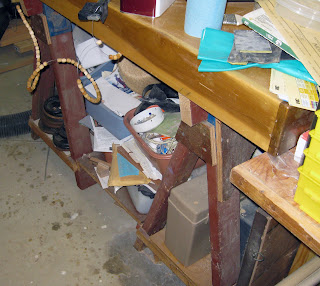The next project is a better set of legs for the T-Box in the shop. As the following picture shows, the current arrangement has a number of limitations, include inefficient use of space, and difficulty in moment.
The new set of legs will have a set of locking castors, a mortise and tenon frame, with provisions made for leveling the T-box.
 |
| The current T-Box leg set. |
First task is to get the legs milled and assembled...
 |
| First side jointed.... |
 |
| Jointed and milled to dimension on the first two sides.... |
 |
| Some of the wood that was removed in the re-sawing. |
Re-sawing involves the use of the table saw without a guard over the blade. As a direct result, the use of push sticks is strongly advised. When I was re-sawing the wood for the legs, the push-stick contacted the blade.... and shattered. I felt almost nothing - the blade is
very good at cutting!
 |
| The re-saw setup. |
 |
| Shattered push stick. |
 |
| Wood is at final width and hight... |
 |
| ...and trimmed to final length. |
 |
| The locations of the mortises are laid out. |
Next step is to cut the mortises, and glue the legs together.


















































